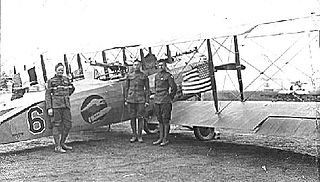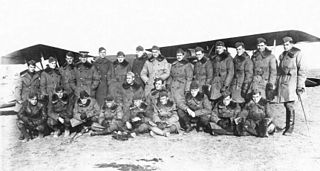
Wilbur Wright Field was a military installation and an airfield used as a World War I pilot, mechanic, and armorer training facility and, under different designations, conducted United States Army Air Corps and Air Forces flight testing. Located near Riverside, Ohio, the site is officially "Area B" of Wright-Patterson Air Force Base and includes the National Museum of the United States Air Force built on the airfield.

Samuel Reeves Keesler, Jr. was a member of the United States Army Air Service in World War I posthumously awarded the Citation Star for gallantry.

The 94th Aero Squadron was the United States Army Air Service designation for the current 94th Fighter Squadron that fought on the Western Front during World War I.

The 95th Aero Squadron was an Air Service, United States Army unit that fought on the Western Front during World War I. It was the first American pursuit (fighter) squadron to fly in combat on the Western Front, beginning on 8 March 1918.

The 12th Aero Squadron was a United States Army Air Service unit that fought on the Western Front during World War I.

The 27th Aero Squadron was a United States Army Air Service unit that fought on the Western Front during World War I.

The 99th Aero Squadron was an Air Service, United States Army unit that fought on the Western Front during World War I.

The 88th Aero Squadron was an Air Service, United States Army unit that fought on the Western Front during World War I.
William Terry Badham was a World War I fighter ace credited with five victories. He was one of four Americans to earn the title of "Ace" as an observer/gunner during World War I.

The 49th Aero Squadron was a United States Army Air Service unit that fought on the Western Front during World War I.

The 103rd Aero Squadron was an aviation pursuit squadron of the U.S. Air Service that served in combat in France during World War I. Its original complement included pilots from the disbanded Lafayette Escadrille and Lafayette Flying Corps. One of those pilots, Paul F. Baer, became the first ace of an American unit in World War I.

The 28th Aero Squadron was a United States Army Air Service unit that fought on the Western Front during World War I.

The 93d Aero Squadron was an Air Service, United States Army unit that fought on the Western Front during World War I.

The 104th Aero Squadron was an Air Service, United States Army unit that fought on the Western Front during World War I.

The 135th Aero Squadron was a United States Army Air Service unit that fought on the Western Front during World War I.

The 139th Aero Squadron was a United States Army Air Service unit that fought on the Western Front during World War I.

The 22nd Aero Squadron was a United States Army Air Service unit that fought on the Western Front during World War I.

The IV Corps Observation Group was an Air Service, United States Army unit that fought on the Western Front during World War I. It was demobilized on 12 May 1919. There is no modern United States Air Force unit that shares its lineage and history.

The 213th Aero Squadron was a United States Army Air Service unit that fought on the Western Front during World War I.

The 168th Aero Squadron was a United States Army Air Service unit that fought on the Western Front during World War I.



















